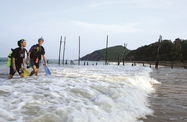Infrastructure and tourism-related programmes will be among the beneficiaries of a new levy on hotel stays that Malaysia’s government is imposing to help fund expansion of the country’s tourism offering.

Approved by Parliament in early April, the bill came into effect on August 1, having been postponed from its initial start date of July 1.
Revenue from the tax – which will apply only to stays by foreign tourists – will be reinvested back into the industry and its supporting infrastructure, according to Nazri Aziz, the minister of tourism and culture.
The levy will be imposed on a sliding scale: guests at five-star hotels pay a surcharge of RM20 ($4.66) per room per night, falling to RM10 ($2.33) for four-star establishments, RM5 ($1.17) for one- to three-star ones, and RM2.5 ($0.58) for budget or unrated accommodations.
Exemptions are made for homestays and kampung (village) accommodations registered with the Ministry of Tourism, as well as for properties run by schools, universities, training institutes or religious institutions, provided there are no plans to use the site for commercial purposes.
Revenue forecasts
Government figures predict the new levy will generate revenues of RM654.6m ($152.8m) in its first full year if hotel occupancy rates reach 60%, rising to RM872.8m ($203.7m) if they hit 80%.
Reaching the latter figure could prove ambitious, with last year’s hotel occupancy rate up 2 percentage points at 65%, according HVS, an industry consultancy. Yet the absolute revenue figure could also rise in the coming years thanks to capacity increases, given the number of new hotels set to come on the market.
If all current projects are completed, more than 25,500 new rooms will be added to the country’s hotel stocks by 2021, for a total of almost 350,000, according to HVS.
Industry voices weigh in
As with any new tax measure, the levy has received a lukewarm response from some industry players and local officials.
Hotel operators have raised concerns that it will harm profitability and reduce cost appeal amid tight regional competition, heightening the risk that tourists will choose alternative destinations over Malaysia.
“Local Malaysian businesses and leisure travellers are already paying for [goods and services tax] and income taxes. Subjecting them to new taxes is of concern,” vice-president of the Malaysian Association of Tour and Travel Agents, K L Tan, told local press, adding it would have the biggest effect on price-sensitive tourists, corporate and incentive groups, and long-haul travellers.
The tax has also met with opposition from key state governments, such as Sabah and Sarawak, which already impose similar levies on the hospitality sector. Both states have sought to defer the implementation of the new national tourism tax, though as of early August no such deferment had been announced.
Growth and forecasts
How much the new levy might impact bookings and tourism numbers is unclear, but at present the sector outlook is strong.
After a downturn in 2015, the industry is enjoying stronger growth in both arrivals and earnings: foreign arrivals rose by 4% last year to reach 26.8m, according to state agency Tourism Malaysia, generating record earnings of RM82.1bn ($19.2bn), up 18.8% on the previous year.
Stronger receipts were also bolstered by longer stays, with the average foreign visitor stay increasing from 5.5 to 5.9 nights in 2016.
Tourism figures for 2016 nonetheless fell short of the official 30.5m target for foreign arrivals.
The new goals set by Tourism Malaysia are to reach 31.8m arrivals and RM118bn ($27.5bn) in revenue this year, rising to 36m and RM168bn ($39.2bn), respectively, by 2020 – more than double the industry’s earnings last year.


